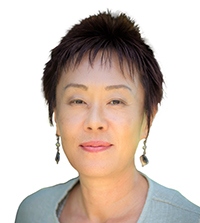11:43 JST, August 18, 2022
In her recent book, “Shadow Traces: Seeing Japanese/American and Ainu Women in Photographic Archives,” Wellesley College Prof. Elena Tajima Creef examines photos of such women in the first half of the 20th century. On the surface, these images, captured under the U.S. colonial gaze, depict the women as obedient, domestic subjects; Creef’s feminist readings, however, uncover traces of their resilience, even resistance, under oppressive conditions.
A chapter on “war brides,” Japanese women who married U.S. servicemen during the Allied Occupation, is of personal significance to the author. As official archives on this group of women are largely absent, she turns her visual analysis to her own family album, which her mother — a war bride herself — put together. Her parents as newlyweds in Japan, her mother taking classes on American-style domestic management, her father as a soldier during the Korean War, and the author and her siblings growing up in the military community — these poignant images, along with the author’s own memories triggered by them, offer a novel perspective on how her parents’ lives and the interracial family they raised were shaped by the greater forces of history.
Creef’s analysis of her family album made me wonder: What can I learn about my own family’s history if I look at our family albums as Creef did hers? My father, an avid amateur photographer, found his two daughters to be fascinating subjects and produced, literally, hundreds of photographs over 20 years. These voluminous photographs would, I thought, surely give interesting insights into my family history. What I learned was quite different from what I anticipated: The photographs that I did not find in these albums speak more loudly about my family history than any photographs that are present.
My mother and father grew up in Tokyo and Yokohama respectively, and their family homes, along with many of their earthly possessions, were destroyed in the firebombing toward the end of World War II. Preoccupied with the day-to-day need to survive, their families did not have time or money to keep photographic records of their children’s growth. Aside from a handful of photos from their young adulthood, mostly taken at school or the workplace, there are practically no visual traces of their earlier lives.
Pictures that capture my parents as a couple are equally scarce. There is a set of formal portraits at their wedding, and a handful of pictures of my mother taken during their courtship and the first year of marriage. But I found no pictures from their honeymoon or any other outings in which they were captured together. Even for the 1960s, when people didn’t take nearly as many pictures as we would today, the scarcity of the representation of their relationship is startling.
I also found no family portraits in which the four of us were pictured together. In fact, my parents had very little photographic presence at all. My mother appears sometimes as a peripheral figure; in most cases, though, only parts of her body are visible — hands that support a baby, feet following behind a toddler, a skirt on which a child clings.
My father is even harder to find. Sure, he was the photographer behind the camera, but did it never occur to him to set the timer so we could all be in the same frame together?
Another glaring lack was the absence of a “family album.” All the albums my parents have kept bear either my name or my sister’s name on their covers. When the prints came back from the camera store, my sister and I would sit down and divide them into my pile and her pile. Whichever of us was captured at the center was supposed get the picture. It was clear that these were our individual albums, and photographs in them were our own possessions, rather than the shared property of the Kurotani family.
These photographic omissions embody my own experience of family life, in which my father was a dominant and absent figure, who watched over us and protected us but, for the most part, was too busy to be present in day-to-day home life. Dissected images of my mother capture — unwittingly — her years of discontent at the fragmentation of herself into a host of domestic functions, also reflecting perhaps my father’s part in keeping her in that fragmented state. Their relationship as a couple was always through their children, without whom their liaison had no purpose. As in the ways of old-fashioned Japanese ie (a household as a corporate unit), my mother, my sister and I all played our expected roles, under the gaze of my father, the head of his household unit.
The void left by incomplete photographic representation also tells the story of the scars that history left on my family more than seven decades ago. Both of my parents experienced traumatic losses and experienced stigma as children of single-parent households during and after World War II. In their adulthood, they were determined to shield their own children from the precarity of life and chose their prescribed gender roles of a salaryman and his stay-home wife as the surest way to achieve financial stability and social respectability. Yet, the absent family portraits tell me that, despite their lifetime of hard work and sacrifice, they were never able to fully recover the comfort of family that they lost in the yakeato (burnt ruins) of their childhood. That is the legacy of war that continues to haunt my family, through the empty pages of the family album that never came into being.

Sawa Kurotani
Kurotani is a professor of anthropology at the University of Redlands.
"Editorial & Columns" POPULAR ARTICLE
-

Violations of Subcontract Law: Major Automakers Must Eliminate Old Practices
-

Local Governments’ Tax Revenues: Devise Ways to Correct Imbalances in Tax Sources
-

Heavy Rains in Asia: Support for Victims, Flood-Control Measures Urgently Needed
-

5 Japanese Business Dinner Mistakes to Avoid — and What They Taught Me About Business in Japan
-

New Nuclear Threat: China Seeking to Follow U.S., Russia in Military Expansion
JN ACCESS RANKING
-

Keidanren Chairman Yoshinobu Tsutsui Visits Kashiwazaki-Kariwa Nuclear Power Plant; Inspects New Emergency Safety System
-

Imports of Rare Earths from China Facing Delays, May Be Caused by Deterioration of Japan-China Relations
-

University of Tokyo Professor Discusses Japanese Economic Security in Interview Ahead of Forum
-

Japan Pulls out of Vietnam Nuclear Project, Complicating Hanoi’s Power Plans
-

Govt Aims to Expand NISA Program Lineup, Abolish Age Restriction























